Replaces
2007 GMC Sierra 1500 Classic 4 Wheel Drive with Front Coil Spring Suspension with Cast Iron Lower Control Arms with Steering Gear without Aluminum Steering Knuckles Front 8 Piece Steering & Suspension Kit TRQ PSA81000
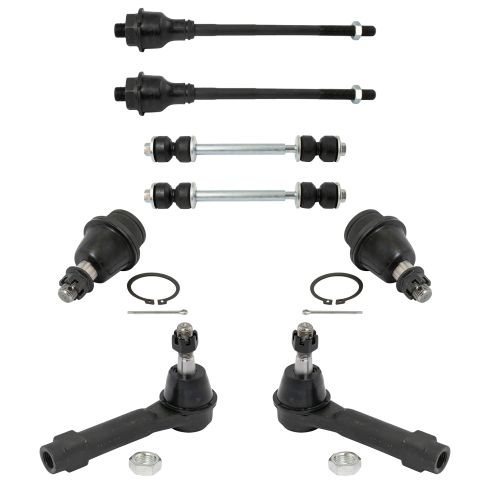

PSA81000
In Stock
This part doesn’t fit a . Select from parts that fit.
Specify your vehicle's year, make and model to guarantee fit.
Orders must be placed by 2pm ET
You may also like
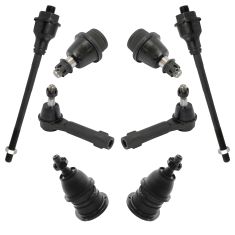
8 Piece Steering & Suspension Kit
$92.95
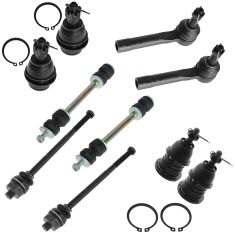
10 Piece Steering & Suspension Kit
$102.95
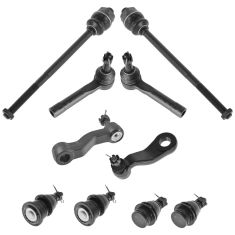
10 Piece Steering & Suspension Kit
$109.95
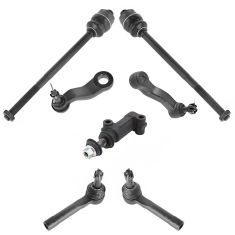
7 Piece Steering Kit
$112.95
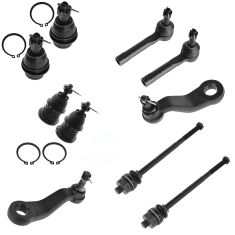
10 Piece Steering & Suspension Kit
$117.95
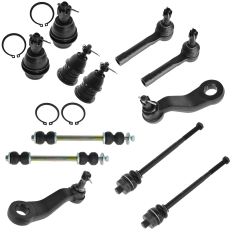
12 Piece Steering & Suspension Kit
$132.95
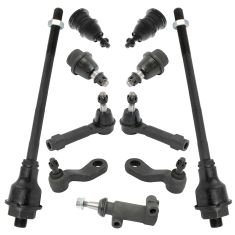
11 Piece Steering & Suspension Kit
$138.95
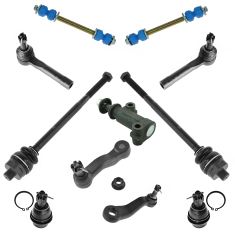
11 Piece Steering & Suspension Kit
$139.95
Part Details
- Quantity: 8 Piece
-
Kit Includes:
(2) Front Sway Bar Links
(2) Front Lower Ball Joints
(2) Front Outer Tie Rods
(2) Front Inner Tie Rods
Specification
- with Front Coil Spring Suspension
- 4 Wheel Drive
- with Steering Gear
- without Aluminum Steering Knuckles
- with Cast Iron Lower Control Arms
- Front
TRQ suspension kits are manufactured using premium raw materials and coatings for extended service life. Each TRQ suspension component is designed to be a direct, maintenance-free replacement to the stock unit. To extend the life of your steering and suspension components, TRQ recommends replacing components in pairs, sets, or kits. All products are fit and road-tested in our Massachusetts R&D facility to ensure we deliver on our promise of Trusted Reliable Quality.
Product Features
Install Tip: When replacing steering components, have a professional alignment performed afterwards. This ensures proper tracking and even tire wear.
Our steering and suspension components are pre-greased and sealed for long life and do not require the extra maintenance typically required by greaseable versions.
Item Condition:
New
Attention California Customers:
![]() WARNING: This product can expose you to chemicals including Lead and Lead Compounds, which are known to the State of California to cause cancer, and birth defects or other reproductive harm. For more information, go to www.P65Warnings.ca.gov.
WARNING: This product can expose you to chemicals including Lead and Lead Compounds, which are known to the State of California to cause cancer, and birth defects or other reproductive harm. For more information, go to www.P65Warnings.ca.gov.
Lifetime Warranty
This item is backed by our limited lifetime warranty. In the event that this item should fail due to manufacturing defects during intended use, we will replace the part free of charge. This warranty covers the cost of the part only.















Created on:
Tools used
Tools used
One of the first things we need to do is safely raise and support the vehicle, so the wheel is off the ground. Let's remove our 22-millimeter lug nuts. Remove your wheel.
Now that the wheel's off of here, we have a clear view of the sway bar link. What you're going to notice is, up along the top, it has a strange-looking nut. It's very thin. It's going to be hard to grab onto. I'm going to use a pair of locking pliers to try to grab onto it. Using my 15-millimeter socket, I'm going to come down from the bottom here. Now I'm going to use my 14-millimeter socket down along the bottom here, see if we can get this to come apart. Looks like it's starting to turn.
Okay. So, for us, the outer sheath on this broke free from the bolt itself that's supposed to be running through the center, so I'm just going to go ahead and spray this down with some penetrant, let that soak down and through there. Sometimes, what happens is, is this outer portion will actually freeze or get stuck onto the bolt. If that's the case, what you would either want to do is grab onto the outer portion with some locking pliers, and then try to spin out that bolt. If that doesn't work, you might have to just cut the bolt itself. There's the bolt. Let's get all this out of here. Awesome.
So, now, assuming you're doing the sway bar links as a pair, now is the best time to go ahead and start doing the other side as well. Okay. Once you have both sides out, you should be able to move the bar around a little bit at this point. We're going to grab our new sway bar links. We take off the nut, take off the washer and the bushing, the washer and the bushing, and then, of course, the sheath, washer and bushing again, and we're going to leave it just like this.
Now, as we come up, okay, coming up from under the control arm, we still have the bolt with the washer and the bushing. Now we're going to take our bushing with our washer, put that facing down and towards the control arm. Grab your spacer, put that on there. We're going to push this up a little bit further. Now you're going to go washer, facing up, bushing. Get it underneath that sway bar. Bring it up. Bushing again.
If you were to look at these bushings, you can tell that they have like a rounded area, and then they have this area right here with a little like a piton. The piton is going to be going either towards the control arm or towards the sway bar. Set that on there, this one right here, and then, of course, our locking nut. I like to use a little thread locker on these.
I'm just going to use my 14-millimeter wrench, and of course, my ratchet underneath, and I'm going to start snugging it up. As I snug it, I want to be watching these bushings. What I want to see is the bushing touching up against the bar, on both sides of course. And, of course, down by the control arm there, we want those bushings to be touching up against it as well. We don't necessarily want to continue tightening, though, until the point where they seem like they're getting squished down and even pancaking out. So, let's just snug them up so they're all touching at least, and then we'll continue on.
Okay. So, this looks great. As you can tell, all of my bushings are touching exactly where they need to be touching. And you're also going to notice that I didn't continue tightening until they flattened out, like I had said before. This looks pretty great, so I'm just going to take a quick measurement of it. It looks like it's approximately the width of my thumb, personally, so I'm going to make sure that I go approximately the same on the other side of the vehicle.
Okay. Now it's going to be time to get the wheel up on here. Slide it on. Now we'll get the lug nuts on here, we'll bottom them out, and then we'll torque them to manufacturer specifications. Let's torque these lug nuts to 140 foot-pounds. Torqued.
Tools used
Before you start, you wanna be aware that after you're done this job, you're gonna wanna go to an alignment specialist so that you can have the vehicle aligned so you don't wear out the tires prematurely.
I'm gonna remove the wheel. Use a 22-millimeter socket, take the lug nuts off. And take the wheel off.
I'm gonna loosen up the jam nut. You can use a 22-millimeter wrench or a 7/8 wrench. Just get that loose. That's good. I'm just gonna spray a little rust penetrant on here. Gonna use an 18-millimeter socket, take this nut off. And if the nut doesn't come off and the stud starts spinning, you can use an 8-millimeter socket to hold that stud from spinning and then just use the wrench to take the nut off. Now you can take a hammer and just give a tap on the bottom of the tir rod or take a pickle fork and separate it this way. Just if you use a pickle fork, it's probably gonna rip the boot right here. So I'm just gonna give it a hit right here. There we go. And now we're gonna take the outer tie rod off. As we unscrew this, just count the threads. So 1, 2, 3, 4, 23, 24. So write that number down and when you go to put it back together, you're gonna count them to put the other one in the same position that that one was in.
And take the new tie rod end. Get this started. Make sure you count. One, 2, 3, 4, 5, 22, 23, 24. And line this up in the knuckle. Take the castle nut. Get that started. Now what you can do is to prevent the stud from spinning, you can take a prybar. Just pry in between the knuckle and pry down on the tie rod. Use an 18-millimeter socket and tighten this up. And tighten this to 37 foot-pounds. And then just check to see where the stud...where the hole is for the castle nut and if you need to, you can snug it up a little bit more to get it to line up. And that hole lines up. Now take the cotter pin, slide it through. Should slide through this way. And take some side cutters and just bend it. Just tap it out of the way. And then trim off the excess. And we'll snug up the jam nut. And tighten that to 50 foot-pounds.
Put the wheel back on. And the lug nuts. Now we're gonna tighten these lug nuts down to 140 foot-pounds and I'm gonna do it in a cross pattern to tighten the wheel down evenly. And just go around again, double-check.
Tools used
- Remove the hub cap by loosening the lug nuts Remove the lug nuts and tire
- Using locking pliers to clip onto the top of the stabilizer link Then remove 14mm bolt from bottom of the stabilizer link Remove the stabilizer link with a hammer or reciprocating saw
- Put the stabilizer piece back into place Use four washers, four grommets, and a tube Use a jack stand to help push it through till it appears through the top Tighten the 14mm bolt on the stabilizer link
- Put the tire in place Replace and tighten each lug nut Torque each lug nut in a crossing pattern to 100 ft/lbs Torque the center hub nut to 160 ft/lbs Replace the hub cap and tighten the lug nut caps
Brought to you by 1AAuto.com, your source for quality replacement parts and the best service on the Internet.
Hi, I'm Don from 1A Auto. I hope this how-to video helps you out, and the next time you need a part for your vehicle, think of 1AAuto.com. Thanks.
In this video, we're going to show you how to replace a sway bar link on this 2002 Chevy Suburban, and it's the same part and similar process on these Suburbans from 2000 and 2006. We show you on the passenger's side, but on the driver's side it's the same procedure. The items you need for this include a new sway bar link from 1AAuto.com, a 14mm and 22mm socket and ratchet, locking pliers, a hammer, and a reciprocating saw depending on the condition of your vehicle.
Remove your hubcap by loosening up these lug nut caps and pulling the hub cap. Now, you want to remove the lug nuts. If you don't have air powered tools, you want to do this while the vehicle is on the ground. You can loosen them preliminarily, raise the vehicle and remove the lug nuts the rest of the way, and pull the wheel out. Using locking pliers, clip on to the top of your stabilizer link, and then remove this 14mm bolt. We'll just fast forward as Mike does this.
Now, you want to just hammer the link through. If the link doesn't move, you may have to use a reciprocating saw and cut it. Up top is the old part; below is the new part from 1A Auto. You can see they're identical, and they'll fit exactly the same. You want to put your stabilizer link back into place, starting with a washer and a grommet, then through the hole, then another grommet, then a washer, then the tube; then, before going through the next hole, another washer and grommet; then, on the top another grommet and another washer, then the nut.
Here, we just put the jack underneath the link. That's just to push it up through and compress the washers a little bit so that you can get the nut on the other end. Once I get another nut on, you'll see I just release the jack. You want to obviously be supporting the vehicle with jack stands, and then use your jack to push the bolt of the link up through. Then, you want to tighten up the sway bar link, and you basically want to tighten it up until the rubber bushings are compressed enough so that they're the same diameter as the washers.
Put the wheel back in place, then replace each of your lug nuts and tighten them up. You want to tighten them preliminarily, lower the vehicle, then tighten them the rest of the way. Torque each lug nut in a crossing pattern to 100 foot-pounds. Replace the hubcap, and just tighten up those lug nut caps.
We hope this video helps you out. Brought to you by www.1AAuto.com, your source for quality replacement parts and the best service on the Internet. Please feel free to call us toll-free, 888-844-3393. We're the company that's here for you on the Internet and in person.
Tools used
You wanna keep in mind when you're doing this job, after you're done, you're gonna wanna go to a local garage and have the vehicle aligned so you don't have premature tire wear.
Take this center cap off. We'll just use a straight blade screwdriver. Just get behind here, slide it off. Get the lug nuts off. Use a 22-millimeter socket. Now take the wheel off.
Loosen up this jam nut. I'm gonna use a 7/8 wrench. And just take some rust penetrant, this thing's a little bit rusty. So let that soak a little bit. Now take a 18-millimeter socket. Take this nut off. And take a hammer and just hit the bottom of the tie rod to release it from the knuckle. Just like that. Now I'm gonna take off the tie rod. Just count how many turns you have. So 1, 2, 3, 4, 5, 7, 21, 22. And write that number down. And take the outer tie rod, one, two. And then count the turns that you counted before, 3, 21, 22. Take the jam nut off. I mean, the castle nut off. And slide it in the knuckle. Slide the stud part into the knuckle. Put the nut on. Just gonna use a pry bar. Pry down on the outer tie rod end to prevent the stud from spinning. And just snug this up a little bit. It's the 18-millimeter socket. And torque this to 37-foot-pounds. And if the hole doesn't line up for the cotter pin, just tighten the castle nut until it lines up. Little more. Should be good. Put the cotter pin through. And take my cutters and just bend this over. And just trim the excess. Tighten up this jam nut. I'm gonna use a 13/16 wrench. And if you have the ability to torque it, torque it to 36-foot-pounds.
Put the wheel on. And the lug nuts. And now I'm gonna torque these lug nuts in a star pattern or cross pattern to 140-foot-pounds to tighten the wheel down evenly. And just go around again. Double-check. And put the center cap on.
Tools used
Take the center cap off, we'll just use a straight blade screwdriver. Just get behind here. Slide it off. The lug nuts off. Use a 22-millimeter socket. Now take the wheel off. You need some pliers on the top of the link. Right here. Just watch out for the brake hose. And then underneath, I'm going to use a 14-millimeter socket. There we go. Cut the top off. And slide the bolt straight through like that. Can use a large pry bar. Just pry up. Just take this piece out. Just be careful, don't pry on the steering. I was prying through the frame in the back there. All right. The new link, I'm just going to take this top piece off, set it aside, and you're going to need to take these pieces off as well. And slide this lower part through and then put the bushing, the washer in the same...pretty much the same how it came out. Then up top. Put the bushing, and the washer, and the nut.
Use a 14-millimeter wrench on the nut and a 14-millimeter socket on the bottom. Tighten this up. Then we're going to torque this nut to 89-inch-pounds. That's good. Just make sure the top of this bolt is not rubbing on the brake line. And if it is, then you could always trim the top of the bolt or you can always invert it and have the bolt going straight down.
And put the wheel back on and the lug nuts. And now I'm gonna torque these lug nuts in a star pattern or cross pattern to 140-foot-pounds to tighten the wheel down evenly. And just go around again, double-check. And put the center cap on.
Tools used
Tools used
Before you start, you wanna be aware that after you're done this job, you're gonna wanna go to an alignment specialist so that you can have the vehicle aligned so you don't wear out the tires prematurely.
I'm gonna remove the wheel. Use a 22-millimeter socket. Take the lug nuts off. And take the wheel off. I'm gonna loosen up the jam nut. You can use a 22-millimeter wrench or a 7/8 wrench. Just get that loose. That's good. I'm just gonna spray a little rust penetrant on here. And use an 18-millimeter socket, take this nut off. And if the nut doesn't come off and the stud starts spinning, you can use an 8-millimeter socket to hold that stud from spinning, and then just use the wrench to take the nut off. Now you can take a hammer and just give a tap on the bottom of the tie rod, or take a pickle fork and separate it this way. Just if you use a pickle fork, it's probably gonna rip the boot right here. I'm just gonna give it a hit right here. There we go. And now we're gonna take the outer tie rod off. As we unscrew this, just count the threads. So 1, 2, 3, 4, 23, 24. So write that number down. And when you go to put it back together, you're gonna count them to put the other one in the same position that that one was in.
Now I'm gonna take off the inner tie rod end. I'm gonna use a large adjustable wrench because I don't have a wrench that's big enough to fit this. Slide this over and loosen it up. And eventually we'll get that off. Take the inner tie rod end and get this started. Now we're gonna tighten this up with the adjustable wrench. If you have the ability to torque this, you wanna torque this to 74-foot-pounds. Just do the best you can. That's good. Then you wanna take a grease gun and hook it up to this grease fitting and give it a couple pumps. You can do it until you start seeing the boot move a little bit, then you know there's plenty of grease in there. And take the new tie rod end. Get this started. Make sure you count 1, 2, 3, 4, 5, 22, 23, 24 and line this up in the knuckle. Take the castle nut, get that started. Now, what you can do is to prevent the stud from spinning, you can take a pry bar, just pry in between the knuckle and pry down on the tie rod, use an18-millimeter socket and tighten this up. And tighten this to 37-foot-pounds. And then just check to see where the hole is for the castle nut. And if you need to, you can snug it up a little bit more to get it to line up. And that that hole lines up. Now take the cotter pin, slide it through, actually we'll slide it through this way and take some side cutters and just bend it. Tap it out of the way, and then trim off the excess. And we'll snug up the jam nut and tighten that to 50-foot-pounds. Put the wheel back on and the lug nuts. I'm gonna take these lug nuts down to 140-foot-pounds, and I'm gonna do it in a cross pattern to tighten the wheel down evenly. Just go around again. Double-check.
Tools used
You want to keep in mind when you're doing this job after you're done, you're going to want to go to a local garage and have the vehicle aligned so you don't have premature tire wear. Take the center cap off. I'll just use a straight blade screwdriver, just get behind here, slide it off. Take the lug nuts off. Use a 22-millimeter socket. Gonna take the wheel off. [inaudible 00:00:34] off this jam nut. I'm going to use a 7/8 wrench. And just take some rust penetrant, this thing is a little bit rusty so let that soak a little bit. Gonna take a 18-millimeter socket, take this nut off. And take a hammer and just hit the bottom of the tie rod to release it from the knuckle. Just like that.
Now when I take off the tie rod, just count how many turns you have. So 1, 2, 3, 4, 5, 7...21, 22 and write that number down. Now I'm going to take a large adjustable wrench and loosen up the inner tie rod end. And loosen this up and just slide it off. Take a little thread locker, put it on the threads before you put the new one on and line it up. And then use my adjustable wrench to tighten this up. If you have the ability to use a torque wrench and torque this, you want to torque this to 74 foot-pounds. And take the outer tie rod, one, two, and then count the turns that you counted before. Three...21, 22. Take the jam nut not off...I mean the castle nut off and slide it in the knuckle. Slide the stud part into the knuckle. Put the nut on. Just gonna use a pry bar, pry down on the outer tie rod in to prevent the stud from spinning, and just snug this up a little bit. Use the 18-millimeter socket. And torque this to 37 foot-pounds. And if the hole doesn't line up for the cotter pin, just tighten the castle nut until it lines up. Little more. Should be good. Put the cotter pin through. And take my cutters and just bend this over then just trim the excess.
Tighten up this jam nut. I'm going to use a 13/16 wrench, and if you have the ability to torque it, torque it to 36 foot-pounds. There's a grease fitting right here. Just take a grease gun and give it a couple pumps. And I really give it a couple of pumps until I see the boot move a little bit. And that's good. Put the wheel back on. And the lug nuts. And now I'm gonna torque these lug nuts in a star pattern or cross pattern to 140 foot-pounds to tighten the wheel down evenly. And just go around again, double-check. And put the center cap on.
Tools used
Tools used
Tools used
Now one of the first things you're going to want to do before you start any job is to make sure you're safe as possible. You want to have safety glasses and hand protection at all times. The next thing you're going to want to do is safely raise and support your vehicle so that your wheel is off the ground. Next, if there's a center cap, remove the plastic center cap and that'll expose your lug nuts. Remove all six using a 22-millimeter socket. Remove your wheel.
Now that we have a nice clear view of our tie rods, I'm going to spray down this area right here. This is the adjustment area. Use a little bit of penetrant. That's going to help you along. Using some nice long pliers, I'm going to grab right onto this and I'm going to turn it clockwise. That'll break free this jam nut. Okay, that broke free. Let's remove the nut that holds that outer tie rod end to the knuckle. Now we're going to hit right here on the knuckle to break our outer tie rod end free from the knuckle.
Turn your outer tie rod end counter-clockwise and count the amount of times it turns around as you remove it. One, two, three, and so on. Okay. Write down that corresponding number so you can remember. Now it's going to be time to get the inner tie rod end off of here. Here's the new inner tie rod end. And if you were to look right along this edge right here, that's the area we're going to need to grab onto, and then turn this counter-clockwise to break it free and eventually remove it. So we'll come right under here with our nice long pliers and get it off of there. There we go.
There it is friends. Now it's going to be time to install our new inner tie rod end. You might notice that there's no grease fitting to be able to grease this. Really there is. The grease is going to come right through that hole right there and that'll happen through here, starting at this point right here at this fitting. Put grease here, it comes right through and then of course it fills up the boot on the inner tie rod end. All right. I put some thread locker on here. I'm just going to go ahead and start this thing by hand. Now that we have that, as far as we can get it by hand, let's go ahead and snug it up with our pliers. Bottomed out. Just give it a teeny bit more. Awesome. Let's remove that jam nut. Let's put a little bit of copper never seize on the inner tie rod end threads, and then we'll just work that jam nut up the inner tie rod end quite a bit here. Now that we have the threaded area coded, we have our outer tie rod end, let's go ahead and put that on. And we're going to count it in the same amount of threads that we counted the original one off. That was one, two, three, and so on.
Okay? Just bring this so it's close. Put that node off of there. Put this on there. Let's bottom that out. Now we're going to torque this nut to 48 foot-pounds. All right. So now that we have that torqued, we need to pay special attention to where the slot on the castle nut lines up with the hole in the stud. If it doesn't line up, you need to continue tightening until it does. Okay. So that looks pretty good. Let's try it. That slides right through, just pin it over. The cotter pin is going to ensure that there's no way that this nut can come loose. Now it's going to be time to tighten up your jam nut. To tighten this, we're going to turn it counter-clockwise. When you torque it, you would want to torque it to 37 foot-pounds if you have the ability.
Okay. Just make sure that it's nice and snug. By the time you're finished, make sure your outer tie rod end is nice and parallel to the ground or at least as parallel as it can be. Now it's going to be time to get the grease fitting out of here. Use your 8-millimeter. There it is. Let's clean off around the area. Grab your new grease fitting. We'll start it right in there by hand, and then we'll snug it up, nice and tight. Let's give it a little grease
Now let's get the wheel back up on here. Okay. Now with the wheel barely on the ground so it can't spin, we're going to torque the lug nuts to 140 foot-pounds. Torqued. If you have a center cover, put it on there now. Now that you've finished your service, go ahead and take it for a road test and make sure you get it down to a local reputable alignment shop.
Tools used
I'm going to use a 22-millimeter socket to take off the lug nuts so we can remove the wheel, then I remove the wheel. So I'm going to use some pliers at the top of the sway bar link right there, and then underneath, I'm gonna use a 14-millimeter socket and just take the link out. A long bolt goes straight through just like that. And take the top off just like that. Now just take a pry bar underneath here. Just raise up on the sway bar, take the link out, all right. So we'll just take the new link apart, and just leave the washer and the bushing on this long bolt. And take the other bushing and the washer, line that up first.
And then this tube goes next. Slide that bolt through, and then another washer and the bushing. Align this up and slide the bushing and the washer. Pry down on the bar. And then it would help if you had someone to help you out to pry this while you're holding this and getting the nuts started. All right, that's good. And then use a 14-millimeter wrench for the nut and a 14-millimeter socket and tighten this down. And then you want to torque this to 89 inch-pounds. Make sure you're on inch-pounds, not foot-pounds. Now, put the tire back and lug nuts. Now we're gonna torque the lug nuts to 140 foot-pounds in a star pattern or a cross pattern so that it tightens the wheel down evenly. And just go around again. Double Check.
Tools used
Tools used
Now one of the first things you're gonna wanna do before you start any job is to make sure you're safe as possible. You wanna have safety glasses and hand protection at all times. The next thing you're gonna wanna do is safely raise and support your vehicle so that your wheels are off the ground. Next, if there's a center cap, remove the plastic center cap and that will expose your lug nuts. Remove all 6 using a 22-millimeter socket. Remove your wheel. Now that we have a nice clear view of our tire rods, I'm gonna spray down this area right here. This is the adjustment area. Use a little bit of penetrant. That's gonna help you along. Using some nice long pliers, I'm gonna grab right onto this and I'm gonna turn it clockwise. That'll break free this jam nut. Okay, that broke free. Let's remove the nut that holds the outer tie rod end to the knuckle.
Now we're gonna hit right here on the knuckle to break our outer tie rod end free from the knuckle. Turn your outer tie rod end counterclockwise and count the amount of times it turns around as you remove it. One, two, three and so on. Okay. Write down that corresponding number so you can remember. We have our outer tie rod end. Let's go ahead and put that on. And we're gonna count it in the same amount of threads that we counted the original one off. That was one, two, three and so on. Okay. Just bring this so it's close. Get that nut off of there. I'm gonna put this on there. Let's bottom that out. Now we're gonna torque this nut to 48 foot-pounds. All right. So now that we have that torqued, we need to pay special attention to where the slot on the castle nut lines up with the hole in the stud. If it doesn't line up, you need to continue tightening until it does. Okay, so that looks pretty good. Let's try it.
That slides right through. Spin it over. The cotter pin's gonna ensure that there's no way that this nut can come loose. Now it's gonna be time to tighten up your jam nut. To tighten this we're gonna turn it counter clockwise. When you torque it, you would wanna torque it to 37 foot-pounds if you have the ability. Let's see here. Okay. Just make sure that it's nice and snug. By the time you're finished, make sure your outer tie rod end is nice and parallel to the ground or at least as parallel as it can be. Now let's get the wheel back up on here. Okay. Now with the wheel barely on the ground so it can't spin, we're gonna torque the lug nuts to 140 foot-pounds. Torqued. If you have a center cover, put it on there now. Now that you've finished your service, go ahead and take it for a road test and make sure you get it down to a local reputable alignment shop.

PSA81000
In Stock
Product Reviews
877-844-3393
Monday - Friday 8:00am - 9:30pm ET
Saturday - Sunday 8:00am - 4:30pm ET
Specify your vehicle's year, make and model to guarantee fit.
This part doesn’t fit a . Select from parts that fit.



















